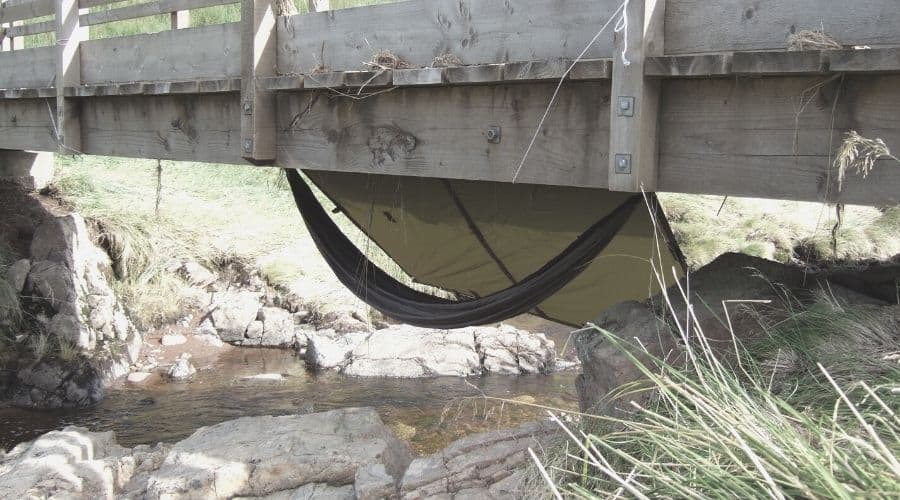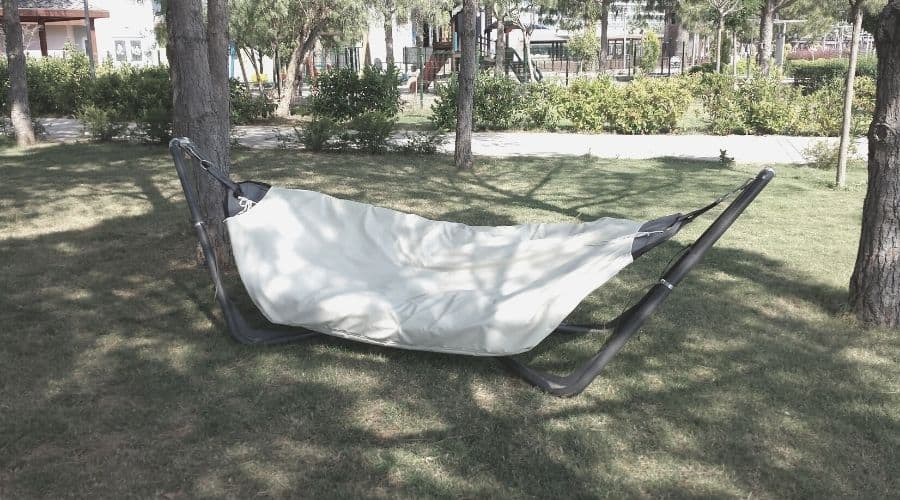No Trees? How to Hang a Hammock?
Necessity, they say, is the mother of invention. So, when it’s necessary to get your hang on in your hammock but you don’t have the usual anchor points (trees!), it’s time to get inventive. In this article, we’ll lend a helping hand with a simple, easy-to-follow guide on how to hang a hammock without trees.
When out in the backcountry, one huge advantage is knowing plenty of knots for hammocks – if you’re armed with some rope/straps and a half dozen or so knots, you can usually figure out a way to get your hammock pitched.
Hammock Camping
There are several ways to hang a hammock when hammock camping, even when trees are in short supply:

Build a Hammock Structure
If you have plenty of time on your hands and like a challenge, one option is to purpose-build a hammock structure. This is probably only likely to be an option for those who plan on spending at least a few nights camping with a hammock in a single location as it can take 3-5 hours, even if you happen to have the right materials to hand and don’t have to hunt for them.
Here’s the simplest way to go about it:
1. Source two large, relatively straight branches to use as stakes. Ideally, these should measure 7-8 feet in length.
2. Dig two holes, roughly 10-12 feet apart and at least 2 feet deep.
3. Hold the stakes upright in the holes and replace the displaced soil.
4. Stamp around the base of the stakes to consolidate the soil*.
5. Attach two lengths of rope or cord to each stake – one roughly halfway up and the other three-quarters of the way up.
6. Attach your hammock tree straps to the stakes (as described in our post on How to Hang a Hammock) and your hammock to the straps.
7. Peg out both stakes using all four guy lines/lengths of rope, attaching them with an easily adjustable knot – a clove hitch works best – and ensuring the cord/rope is taut.
8. Weight your hammock with a backpack or rocks.
9. Adjust the tension in your guy lines.
10. Check your angles – make sure there is roughly a 30-degree angle between the stakes and the hammock straps on the lower side of the stake.
11. Hop in! Well, ease yourself in gently, slowly transitioning your weight to test your setup’s stability.
* This setup can be stabilized further if you manage to source a large branch to use as a “ridgeline”, positioning it horizontally above your hammock between the two vertical stakes. By lashing this branch between the two others you’ll reduce the tension on your branches and guylines, making the whole system more stable.

Hammock Stands
Hammock stands might add significantly to the cost of you hammock camping setup, but they’re highly practical, secure, and very easy to use.
The main benefits of a collapsable hammock stand are that you can use it just about anywhere you’re willing or able to carry it and that you can hang your hammock in a matter of seconds without having to play around with straps and knots.
The main downsides to a hammock stand are that they cost a pretty penny and are too heavy to be used for anything other than car camping.
Setup is a cinch, with most models using a hammock that attaches to the stand with pre-measured straps, chains, or cord. All you have to do is choose your pitch location!
Cars & Trucks
If your vehicle has a sturdy roof rack or roll bars, these can be used as an anchor point for your hammock in the absence of two trees.
The upside of this setup is that – if you have two vehicles with racks – you can hang your hammock just about anywhere. The downside is that if you only have one car available, you’ll have to park close enough to a second anchor point to complete your setup.
Attaching your suspension straps close to where the rack attaches to your car roof – this reduces tension on the rack and reduces the risk of pulling it off if you place too much weight in the hammock.
As with regular pitching, aim for a 12-15 distance between your two anchor points and a 30-degree angle between the suspension straps and vehicle on the lower side.
Instead of moving your vehicle, if your system’s too slack, simply wrap your suspension straps around the bar of your roof rack a few more times before feeding it through the loop – each wrap will take the slack out of the system in 3 or 4-inch increments.

Rocks
If you happen to be hammock camping in the desert or above the treeline, rocks may well be the only anchor points available.
In this situation, you can still pitch your hammock safely and securely by carrying a small selection of camming devices (aka “friends” or “cams”), stopper nuts, and large slings (120+ cm) which can be inserted into cracks in the rock (cams, nuts) or slung over flakes (slings) to create solid, reliable anchors.
If you don’t have any of the above hardware, hit up a climber friend, who’s sure to have the lot.
Haning a Hammock at Home or the Backyard
With just a little bit of creativity and effort you can easily hang your hammock at home without needing trees by employing one of the following methods:

Posts/poles
By far the easiest way to hang a hammock in a tree-free yard is to create your own substitute trees using posts or poles.
There are two ways to go about it. The first entails following the instructions for making a hammock structure when camping featured above, only you will need to use purchased stakes instead of trees or branches. The second is more permanent and time-consuming but offers a more solid setup by using concrete instead of plain old earth to pack in and support your posts or poles.
Because these methods are very similar barring this one exception, our step-by-step guide covers both:
1. Choose your pitching location, bearing in mind which parts of your yard receive sunlight at which times of day and when you’re most likely to do your hammocking. If you’re using concrete, also remember that this is a large-ish installation that will be difficult to remove once in place.
2. Dig two holes in the ground, both roughly 2-2.5 feet deep. These should be 10-15 feet apart if you are hanging your hammock suspension straps. If you don’t plan on using suspension straps, measure the length of your hammock very carefully before you start digging.
3. Prepare your poles/posts. These should be 6-8 feet in height and at least 5 inches in diameter if you use wood as opposed to metal. With wood, you can make a notch (or series of notches) in the upper quarter of the post to help keep your straps in place.
4. If you plan to use concrete, then fill the hole with the concrete, leave it to set for 12-14 hours or until it’s hard enough to support your poles/posts, then plump your pole in the middle. To make sure the pole stays upright and straight, we recommend setting up some guylines.
5. If you’re set up is sans concrete, then place the post/pole in the center of your hole and fill in the hole with the displaced soil. Stamp the soil to consolidate.
6. Attach your hammock (and straps) to the pole and hop in!

Buildings
Unless you happen to have joists, columns, bannisters, or other features around which you can wrap hammock suspension straps, hanging your hammock in or on a building can be a little tricky. But that doesn’t mean it can’t be done…
The easiest way is to create to anchors at home is to use J-hooks. These two-part hammock hooks consist of a screw and a hook connected by two closed loops and can be used in any solid wall or beam. If you’re hanging your hammock from your walls, we recommend you find a studfinder to locate the framing studs, which will provide a far more solid anchor than plain walling surface.
1. Chose your location. As always, your anchors should be 10-15 feet apart if using straps. If attaching your hammock directly to the anchors/J-hooks, you’ll have to measure your distances very carefully beforehand to get the correct tension and angle, which will naturally depend on the size of your hammock.
2. Place the hooks in the wall roughly 5/6 feet from the flooring (lower is OK if not hanging with straps).
3. Attach your hammock or straps to the hooks and, if hanging with straps, adjust the tension as needed.
4. Test out the solidity of your setup before jumping in by weighting it with anything at hand (and which won’t damage your flooring if it collapses!) until loaded with a similar weight to that of the hammocker.
Use Your Hammock as a Tarp
Sometimes, the weather just refuses to play ball. If you happen to be out hammocking without a rain tarp in such a situation, there are a few ways in which you can avoid a soaking. One of these involves hightailing it for your vehicle, the other improvising a rain shelter out of your hammock.
But how’s it done?
In a standard hammock setup, the fabric of the hammock lies in a U-shape, which means it would collect water in the event of rainfall. By inverting the setup, however, you can make a passable rain shelter that will keep off the worst of the H20 until the shower has passed.
Here’s how to do it:
1. Keep your hammock attached to its anchors, but rotate the S-hooks (if used) so the tip of the inward part of the ‘S’ faces down instead of up.
2. Find a large stick/branch, measuring at least a foot or two taller than the ridgeline of your setup or the height of your anchors.
3. Cover the top of the stick with a sweater to protect the hammock fabric, push it up into the center of the hammock, and place the other end on on the ground. Adjust the tension on your straps to keep the stick in place if need be.
4. Stretch out one or both of the lateral sides of the hammock by bunching up a handful of fabric, tying a knot around it with a cord or rope guyline, and pegging this into the ground to extend coverage.
OR
Angle another stick (or sticks) diagonally outward from the point where the main stick is positioned in the ground towards the edge of the hammock to create a kind of A-frame configuration.
Conclusion
Hammocking without trees to use as anchors might be tricky, but with a little bit of know-how and creativity it can be done, as demonstrated in the list of ways to hang your hammock without trees, we have featured above. Whether you’re at home or out in the wilds, these techniques will hold you in good stead and keep you hammocking no matter where your adventures take you.
How did you like our article? If you find it useful or have any questions, feel free to post a comment in the box below. And if you’d like to share this post with your friends, go ahead!

